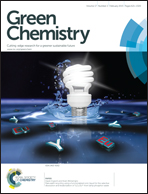Nitrogenated graphene and carbon nanomaterials by carbonization of polyfurfuryl alcohol in the presence of urea and dicyandiamide
Abstract
Most of the numerous emerging synthetic routes toward functionalized few- and multilayer graphene employ fossil resources such as graphite together with polar solvents. Herein we report on the solvent-free preparation of nitrogenated graphene and green carbon nanomaterials exploiting furfuryl alcohol (FA) and urea as renewable feedstocks. Typically, polyfurfuryl alcohol (PFA) reactor blends, prepared by cationic polymerization of furfuryl alcohol in the presence of urea or dicyandiamide (DICY), respectively, are carbonized by thermolysis. In sharp contrast to conventional PFA thermolysis, as verified by a microscopy (SEM, TEM, AFM) and WAXS, only PFA thermolysis in the presence of urea and DICY affords nitrogenated functionalized multilayer graphene. This is attributed to the in situ formation of carbon nitride nanosheets as thermally degradable template. Variations of process parameters such as the temperature ramp and the FA/urea and FA/DICY molar ratios enable control of graphene morphology development and properties. Thus, our green carbon approach toward functionalized multilayer graphene holds promise for fabricating renewable carbon nanosheet materials, meeting the demands of manifold applications.


 Please wait while we load your content...
Please wait while we load your content...